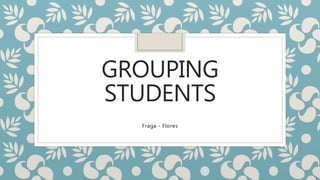
Power Point Presentation. Text "Grouping Students". Fraga - Flores
- 2. Whole-class teaching Sitting in rows, listening to a teacher who stands in front of them. Teacher- student interaction. Advantages: It reinforces a sense of belonging among the group members. It is much easier for students to share an emotion. It is suitable for activities where the teacher is acting as a controller. Good for explanations and instructions. It is an ideal way of showing material. It is also more cost efficient both in terms of material production and organization. Disadvantages: It favors the group rather than the individual. Many students are disinclined to participate in front of the whole class since to do so brings with it the risk of public failure. It may not encourage students to be autonomous. It favors the transition of knowledge from teacher to students.
- 3. Students on their own Individualized learning Advantages: It allows teacher to respond to individual students differences. It promotes the development of the learners' autonomy. Disadvantages: It does not help the class develop a sense of belonging. It does not encourage cooperation. It requires more thought and materials preparations than whole-class teaching involves.
- 4. Pair work Students can practice language together, study a text, research language or take part in information-gap activities. Advantages: It increases the amount of speaking time. It allows students to work and interact independently without necessary guidance of the teacher, thus promoting learners’ independence. It allows teachers time to work with one or two pairs while the other students continue working. It promotes cooperation and helps the classroom to become a more relaxed and friendly place. It allows them to share responsibilities. Relatively quick and easy to organize. Disadvantages: It is often really noisy. It can often veer away from the point of an exercise. Chances of misbehavior. Can be problematic if they have to work with someone they are not keen on.
- 5. Group work We can put students in larger groups. This will allow them to do a range of tasks for which pair work is not appropriate. Advantage: Small groups of five provoke grater involvement and participation rather than larger groups. It increases the amount of talking. Personal relationships are less problematic, there is a greater chance of different opinions and varied contributions than in pair work. It encourages broader skills of cooperation and negotiation than pair work. It promotes learner’s autonomy Disadvantages: It is likely to be noisy. Not all students enjoy it. Individuals may fall into group roles that become fossilized. Groups can take longer to organize.
- 6. Ringing the chances Deciding when to put students in group or pairs, when to teach the whole class or when to let individuals to get on with it on their own depends upon a number of factors… ◦ The task ◦ Variety in a sequence ◦ The mood
- 7. Organizing pair and group work Making it work • Doing a group activity with students and then ask them to write or say how they feel about it. • Ask them to list their favorite activities and compare these lists with their classmates. When we know how our students feel about pair work or group work, we can decide what changes of methods we need to make Creating pairs and groups • Friendship (observation). • Streaming (ability/level). • Chance (no special reason). • Changing groups.
- 8. Procedures for pair and group work Our role in pair and group work does not end when we have decided which students should work together. We have other matters during and after the activities. During: ◦ While students are working stand up at the front or in the side of the class and keep an eye on what's happening. In this position we can tune in to a particular group from some distance away. ◦ Go round the class watching and listening to specific groups or pairs. Then intervene if you think it is appropriate or necessary. After: o When groups stop working together we need to organize feedback, this procedure will give students information for future learning and action. o Sharing ideas, solutions, problems, etc., help them get a better understanding of the topic. o Constructive feedback enhance students’ future motivation.
- 9. Troubleshooting Finishing first When we see the first group finished the task we might stop the activity for the whole class. That removes the problem of boredom but it may be very demotivating for the students who have not finished yet. When planning group work it is a good idea to plan extra activity for the first-finishing groups. Awkward groups In order to make all participants work, we sometimes have to reorganize pairs or groups.